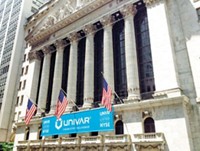Advertisement
Grab your lab coat. Let's get started
Welcome!
Welcome!
Create an account below to get 6 C&EN articles per month, receive newsletters and more - all free.
It seems this is your first time logging in online. Please enter the following information to continue.
As an ACS member you automatically get access to this site. All we need is few more details to create your reading experience.
Not you? Sign in with a different account.
Not you? Sign in with a different account.
ERROR 1
ERROR 1
ERROR 2
ERROR 2
ERROR 2
ERROR 2
ERROR 2
Password and Confirm password must match.
If you have an ACS member number, please enter it here so we can link this account to your membership. (optional)
ERROR 2
ACS values your privacy. By submitting your information, you are gaining access to C&EN and subscribing to our weekly newsletter. We use the information you provide to make your reading experience better, and we will never sell your data to third party members.
Business
On The Auction Block
Though chemical patents were offered at this year's second public sale, they found few bidders, no buyers
by Marc S. Reisch
November 20, 2006
| A version of this story appeared in
Volume 84, Issue 47

In New York City late last month, Chicago-based Ocean Tomo conducted its second live intellectual property auction. As in the firm's first auction, in San Francisco back in April (C&EN, June 12, page 24), buyers showed interest in chemistry-related lots, but the lots that attracted the greatest number of bids and sales were related to software and telecommunications.
About 400 people attended the New York City event, held inside the former Bowery Savings Bank, a beaux art jewel in the heart of what was once the city's Skid Row. Within two hours, the auctioneer raised $21.7 million, not including the 10% premium that Ocean Tomo, which bills itself as an intellectual capital merchant bank, charged buyers. The firm sold about one-third of the more than 65 lots, which included 275 patents, trademarks, domain names, and copyrights. Not one of the chemical-related lots sold.
Inflating the final sales figure was the $15 million sale of rights to the music catalog of rock 'n roll icon Jimi Hendrix to an unidentified buyer. A cloud hangs over that sale, though, as the family of Hendrix, who died in 1970, says it owns the music rights. Excluding the sale of that celebrity lot, the auction brought in $6.7 million, more than twice the amount raised at the April event in San Francisco.
Andrew T. Ramer, president of Ocean Tomo Auctions, expects the firm's next auction, planned for April 2007 in Chicago, to do even better. He anticipates it will "reach our maximum of 100 lots."
"Buyers seemed fairly sophisticated," said Lanning G. Bryer, an attorney with the firm of Ladas & Parry who attended the auction. "They zeroed in on what they wanted."
Sellers included Motorola, BellSouth, and IBM and not "fly-by-nighters," Bryer noted. With the backing of such blue-chip participants, he said, public auctions might just establish themselves as a viable way for firms to monetize unused corporate patents. But he also warned that companies should be cautious about offering patents in a forum where they can't control the buyer, lest the patents be used against them.
Chemical firms put up more than 10% of the roughly 275 patent and other property rights that were on the auction block. Eastman Chemical, for example, offered four patents bundled into two separate lots. One lot covered the design of an insulated beverage container, while the second lot covered the manufacture of a number of silicone polymer blends with nylon.
Dow Chemical offered 27 patents, also in two lots. The first lot of six patents covered triazole-based fungicides. According to the auction catalog, Dow acquired these patents when it bought Rohm and Haas's agricultural chemicals business in 2001. The second lot of 21 patents included both Dow and former Rohm and Haas patents, all of which cover the use of strobilurin fungicides. According to an Ocean Tomo representative, the buyer would need to spend millions of dollars to register these fungicides with the Environmental Protection Agency before they could be used in the U.S.
The auctioneer started bidding on the first Eastman patent at $20,000 and on the second at $50,000. No bids were made for either lot.
The Dow triazole fungicide lot started at $30,000 and attracted a number of bids, including some from telephone callers who listened in and made their bids with the help of the auctioneer's agents. The lot was withdrawn from sale after a final $45,000 bid did not reach Dow's minimum reserve. The auctioneer started bidding on the strobilurin fungicides at $150,000 but quickly lowered the offering price to $50,000. Following some active bidding, the price rose to $85,000. But again the auctioneer withdrew the lot because it did not meet Dow's preset reserve.
Lindsay S. Adams, a patent attorney at Pitney Hardin, observed that the intellectual property that sold well at the auction did not have the regulatory burdens of the chemical-related patents. Those that sold well could also be leveraged across a wide potential market. A video-on-demand system, for example, sold for $900,000, and a computer virus screening method sold for $700,000.
Separately, Adams noted that a recent Supreme Court decision will make it more difficult for a patent holder to enforce its rights by obtaining an injunction against a suspected infringer. Patent buyers might be more cautious purchasing patents if they can't easily enlist court help against infringers, Adams reasons. In addition, another case now being argued before the Supreme Court may raise the bar on what is truly novel and patentable under what are referred to as "obviousness" standards.
According to Adams, about 10% of patents are contested in court. Of those contested patents, about half are ruled invalid under the obviousness standards. Should the Supreme Court change the standards, many more patents could fail to hold up. Depending on how the courts deal with these issues, he said, future interest in the sale of patents could be lower than it is today.
Legal issues notwithstanding, Ocean Tomo is counting on continued interest in patent sales at next spring's Chicago auction and at one planned for London on June 1 containing both European and U.S. patents.
Ragnar R. Olson, an analytical chemist and registered patent agent who joined Ocean Tomo recently, says the firm is still bullish on chemical patents, including the nanotech and fuel-cell-related patents it may auction off in April. Though chemical patents did not sell at the New York City auction, Olsen said some of them are likely to be sold privately over the next few weeks.




Join the conversation
Contact the reporter
Submit a Letter to the Editor for publication
Engage with us on Twitter